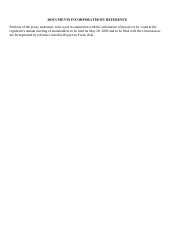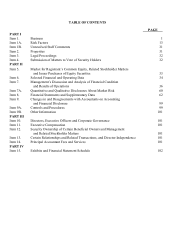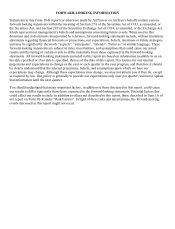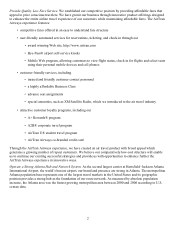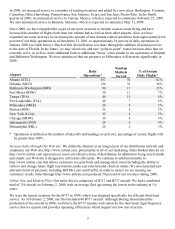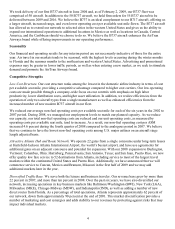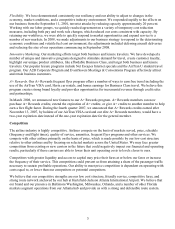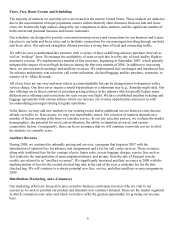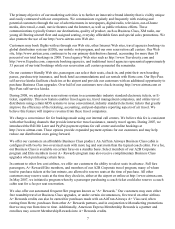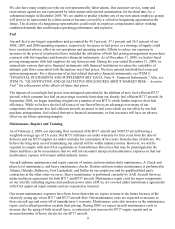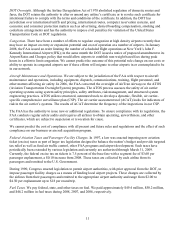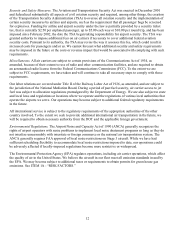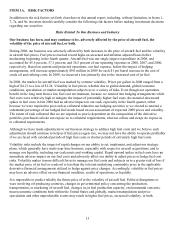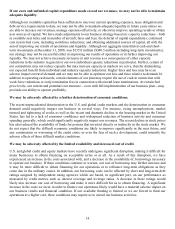Airtran 2008 Annual Report Download - page 13
Download and view the complete annual report
Please find page 13 of the 2008 Airtran annual report below. You can navigate through the pages in the report by either clicking on the pages listed below, or by using the keyword search tool below to find specific information within the annual report.Flexibility. We have demonstrated consistently our resiliency and our ability to adjust to changes in the
economy, market conditions, and a competitive industry environment. We responded rapidly to the effects on
our business from the September 11, 2001, terrorist attacks by reducing capacity approximately 20 percent.
Working with our labor groups, we quickly reached agreement on a variety of temporary cost reduction
measures, including both pay and work rule changes, which reduced our costs consistent with capacity. By
retaining our workforce, we were able to quickly respond to market opportunities and expand service to a
number of new markets. In 2008, we made adjustments to our business strategy to respond to the deteriorating
economic conditions and volatile fuel cost environment; the adjustments included deferring aircraft deliveries
and reducing the size of our operations commencing in September 2008.
Innovative Marketing. Our marketing efforts target both business and leisure travelers. We have developed a
number of unique and innovative programs designed to stimulate demand for travel, create customer loyalty,
highlight our unique product attributes, like affordable Business Class, and target both business and leisure
travelers. Our popular leisure programs include Net Escapes Internet specials and the AirTran U student travel
program. Our A2B Corporate Program and EventSavers Meetings & Conventions Program effectively attract
and retain business customers.
A+ Rewards. Our A+ Rewards frequent flyer program offers a number of ways to earn free travel including the
use of the AirTran VISA card, Hertz car rentals, and bonus earnings for Business Class travel. We believe this
program creates strong brand loyalty and provides opportunities for incremental revenue through credit sales
and partnerships.
In March 2008, we announced new features to our A+ Rewards program. A+ Rewards members can now
purchase A+ Rewards credits, extend the expiration of A+ credits, or give A+ credits to another member to help
earn a free flight faster. During the fourth quarter 2007, we announced that A+ Rewards credits earned after
November 13, 2007, by holders of our AirTran VISA card and our elite A+ Rewards members, would have a
two-year expiration date instead of the one-year expiration date for the general member.
Competition
The airline industry is highly competitive. Airlines compete on the basis of markets served, price, schedule
(frequency and flight times), quality of service, amenities, frequent flyer programs and other services. We
compete with other airlines primarily on the basis of price, which is made possible by our low cost structure
relative to other airlines and by focusing on selected markets across the United States. We may face greater
competition from existing or new carriers in the future that could negatively impact our financial and operating
results, particularly if those carriers are able to lower their unit operating costs to levels closer to ours.
Competitors with greater liquidity and access to capital may price their fares at or below our fares or increase
the frequency of their service. This competition could prevent us from attaining a share of the passenger traffic
necessary to sustain profitable operations. Our ability to meet price competition is dependent on operating with
costs equal to, or lower than our competitors or potential competitors.
We believe that our competitive strengths are our low cost structure, friendly service, competitive fares, and
strong route network anchored by our hub at Hartsfield-Jackson Atlanta International Airport. We believe that
our brand and our presence in Baltimore/Washington, Milwaukee, Orlando, and a number of other Florida
markets augment operations from our Atlanta hub and provide us with a strong and defensible route system.
5




